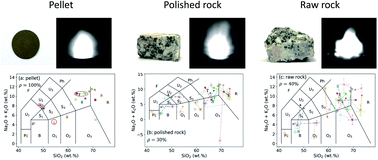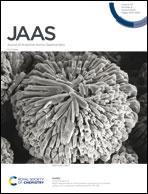Total alkali silica classification of rocks with LIBS: influences of the chemical and physical matrix effects
Abstract
The application of laser-induced breakdown spectroscopy (LIBS) for classification of rocks with the total alkali-silica (TAS) diagram is considered in this work. The attractive feature of LIBS compared to other spectrochemical techniques used for TAS classification in geological studies and especially for Mars exploration, such as X-ray fluorescence (XRF) and alpha particle X-ray spectrometry (APXS), consists in its ability for in situ stand-off analysis of samples in their natural state. The analysis accuracy of LIBS for geological samples, rocks, crusts, and soils, is however, seriously affected by the matrix effects due to the various chemical compositions and the different surface physical states of the samples. In this work with an originally designed experiment, a collection of 20 rocks were analyzed in the three different states: natural rock, with a polished surface and pressed pellets. This allowed the simulation of a real application scenario where a prediction model built with calibration standards prepared in a laboratory in the form of pressed pellets, is used to predict chemical compositions with the LIBS spectra acquired from geological samples in their natural state. In the framework of the TAS classification, the concentration of the major compounds in the rocks, SiO2, Na2O, and K2O, was thus determined first with univariate calibration models which were clearly affected by both the chemical and physical matrix effects. Multivariate calibration models were then developed based on machine learning to predict the concentrations of the above 3 compounds and perform the TAS classification. An efficient reduction of the chemical matrix effect has been demonstrated, and the influence of the physical matrix effect has been investigated in the cases of both univariate and multivariate calibration models.



 Please wait while we load your content...
Please wait while we load your content...